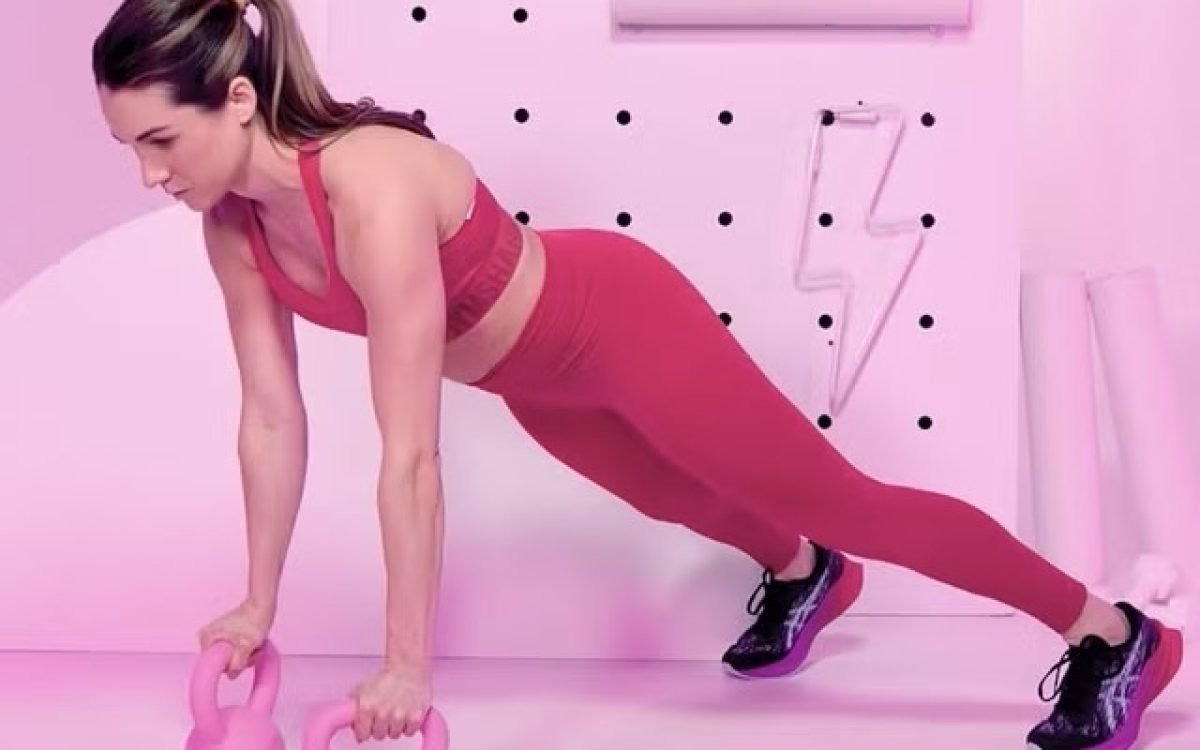Beyond Sit-Ups: Kettlebells as Core Catalysts 🏋️♂️
If your ab routine feels repetitive and stunted, kettlebells offer a game-changing upgrade. Unlike traditional isolations—crunches, planks, hollow holds—a kettlebell moves unpredictably. Its off-center weight and swinging momentum force your body to engage the entire core—deep stabilizers, obliques, rectus abdominis, erector spinae—to maintain balance, posture, and power throughout the movement.
As fitness experts like Lauren Kanski highlight, kettlebell training is not just an abdominal exercise—it’s a full-body experience that naturally recruits your midsection through dynamic, compound patterns, making it elite for core activation, especially if you’re time-pressed.
The Science of Core Engagement with Kettlebells
🔹 1. Core Strength Gains: 70% Increase in Only 8 Weeks
A University of Wisconsin–La Crosse thesis demonstrated that participants performing kettlebell workouts 2 times weekly for eight weeks saw core (plank) strength increase by ~70%, compared to just 11-second gains in a control group, who improved only modestly. The kettlebell group added 45 seconds to their plank hold—evidence of dramatic core endurance gains .
Notably, this effect wasn’t isolated—they didn’t do ab-specific moves. Instead, their routines were loaded with full-body, ballistic patterns like swings, presses, snatches, and get-ups. Yet these delivered targeted core improvement.
🔹 2. EMG Studies: Muscle Activation Mapped
Electromyography research reveals how kettlebells target core muscles differently:
A study comparing one-armed and two-armed swings found significantly greater activation in contralateral upper erector spinae during single-arm swings—highlighting the core’s role in resisting rotation and keeping the spine stable . Rectus abdominis activation increased substantially during the hip extension phase of swings, yet varied by arm style . Other movements like snatches and cleans stimulated external obliques more than swings alone .
In short, kettlebells light up the core’s front, side, and back regions via dynamic, unilateral, and ballistic loading—covering the full spectrum of trunk muscle engagement.
🔹 3. Functional Training = Real-World Benefits
Kettlebell training excels at functional integration—replicating real-life movement patterns involving multiple joints and planes of motion. This translates to better balance, coordination, and spinal stability.
A randomized trial involving workers exposed to frequent perturbations showed kettlebell swings improved postural reaction times by ~109 ms after eight weeks—key for fall or injury prevention . Among older adults (60–80 years), kettlebell programs improved strength and reduced inflammation over 6–12 months .
🔹 4. Ballistic Power + Neuromuscular Efficiency
Kettlebell swings and snatches fall under ballistic training, emphasizing explosive acceleration without deceleration phases . These movements rapidly recruit fast-twitch fibers and require constant core bracing—perfect for strength, power, and endurance. The rhythmic dynamics also enhance neuromuscular coordination and “flow”—a mental state linked to improved cognitive and athletic performance .
🔹 5. Intra-Abdominal Pressure & Spinal Health
Heavy lifts and swings increase intra-abdominal pressure (IAP), stabilizing the lumbar spine while allowing deep breathing. Proper technique ensures co-activation of the diaphragm and transverse abdominis, supporting spinal health and reducing injury risk .
Core-Focused Kettlebell Exercises & Their Specific Roles
1. Kettlebell Swing (Russian or American)
Focus: Hip-extension-driven, ballistic movement. Core Engagement: Planks the posterior chain, rectus abdominis, and erector spinae. Unilateral versions add rotational challenge .
EMG data confirmed contralateral spinal activation during single-arm swings, while rectus abdominis loaded only ipsilaterally in single-arm vs. bi-arm versions .
2. Turkish Get-Up
A slow, multi-step movement that builds total-body control, engaging deep core stabilizers, obliques, glutes, and shoulders .
3. Goblet Squat/Hold
Core challenge: maintain upright posture under load, engaging the abdominals and spinal muscles .
4. Suitcase Carry / Single-Arm Carry
Walking with weight in one hand forces anti-lateral flexion reactions, firing the QL and obliques in real time .
5. Single-Arm Press/Clean/Snatch
Requires core bracing to stabilize trunk during unilateral overhead movement .
Designing a Core-Strengthening Kettlebell Routine
Weekly Structure: 2–3 sessions/week; 30–45 minutes; mix ballistic, unilateral, and hold-based exercises.
Sample Circuit:
Warm-up: breathing drills, hip hinge, light swing. Main Sets (3–4 rounds): 10 Russian swings (choose weight allowing explosive hip snap) 5 Turkish get-ups/side 10 goblet squats 30-second suitcase carry/side 8 single-arm KB presses/side 30-second hollow-body hold (bodyweight) Cool-down: deep breathing, IAP reset, mobility stretches.
Progression Tips:
Increase kettlebell weight every 4–6 weeks. Swap Russian swing for American swing. Add tempo variations to get-ups. Incorporate pauses in carries and holds for endurance.
Programming Mindset:
Train holistic core function—not just abs but the entire midline’s strength, restraint, and responsiveness. Use kettlebells for dynamic resilience, not just brute force.
Benefits of Kettlebell Core Training
Explosive Core Power: Dynamic lifts enhance fast-twitch firing and force transfer. Improved Spinal Health & Posture: IAP and stability reduce injury risk. Enhanced Balance & Coordination: Multi-planar, unilateral movements sharpen neuromuscular control . Functional Strength Carryover: Applicable to activities—lifting, sports, everyday tasks. Time-Efficient Training: Combines strength and cardio; kettlebell circuits torch calories (~800/hr potential) while sculpting the core . Age-Resilient Fitness: Safe and effective across age groups . Neuromotor and CV Gains: Enhances coordination, flow state, and aerobic thresholds.
Caution & Technique Musts
Master Hip Hinge First: Avoid knee-and-arm “lifting”—drive from the hips . Use Breath & Bracing: Coordinate deep inhales with core activation under load . Progress Slowly: Begin light, refine form, then advance. **Unilateral Precision
The Secret to Sculpted Abs? Kettlebells Might Just Be the Core Revolution You Need
Sit-ups. Planks. Hollow holds. We’ve all done them—and probably gotten bored of them, too. They’re reliable for working the abs, no doubt. But if your goal is a strong, functional, and sculpted core, it might be time to level up your training. Enter the kettlebell—a humble-looking cast-iron ball with a handle that might just be the most underrated tool in your fitness arsenal.
Kettlebell training isn’t just about lifting heavy. It’s about moving smart. And when it comes to core strength, kettlebell movements are among the most effective, science-backed, and dynamic exercises you can perform.
Why the Kettlebell Is a Core Game-Changer
Kettlebells are unique because of their offset center






